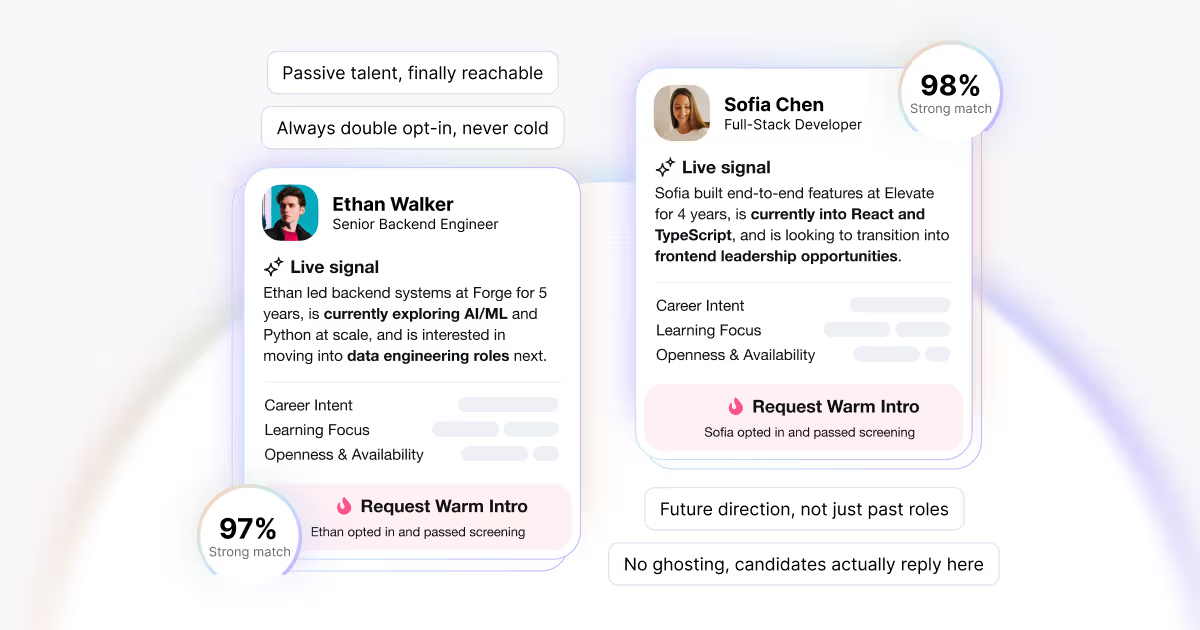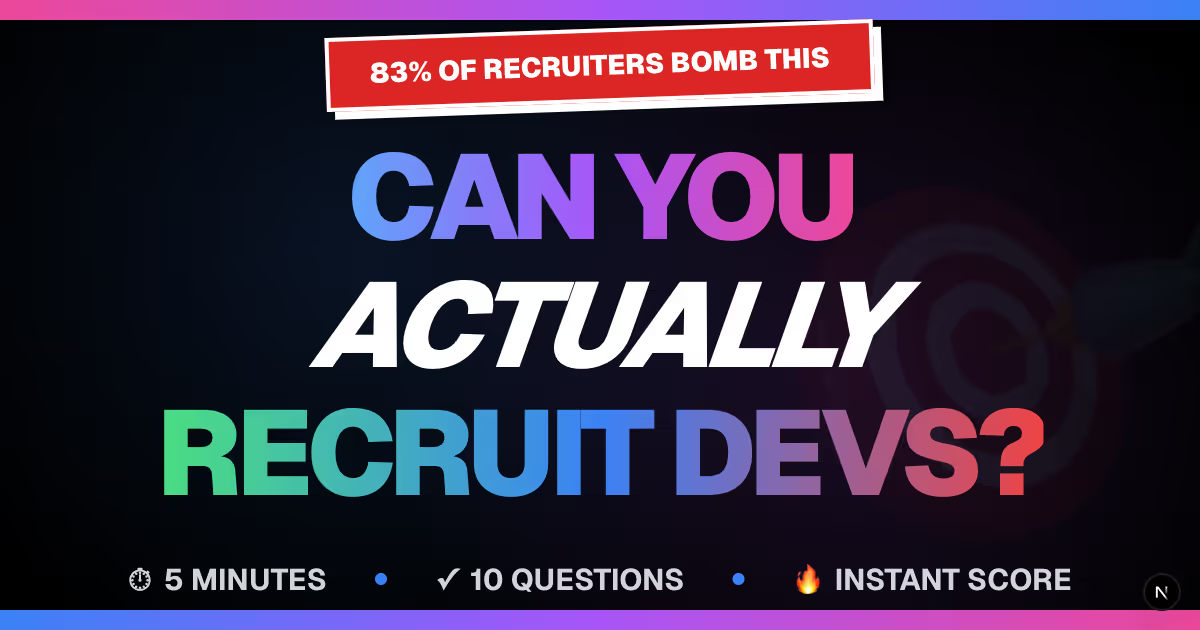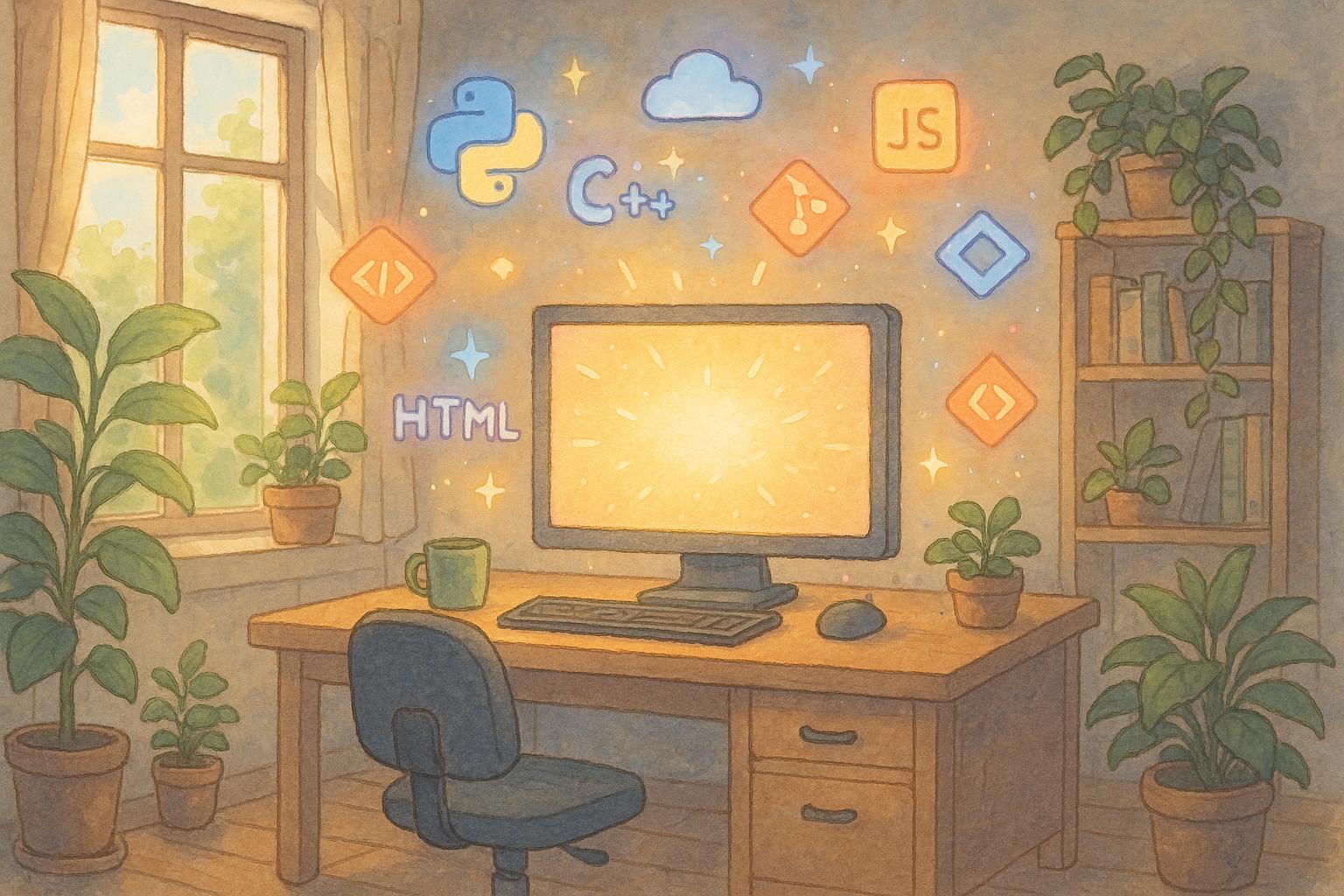


Learn how warm introductions can transform developer recruitment, boosting engagement and improving hiring outcomes with practical strategies.
Warm introductions are a game-changer in developer recruitment. Instead of sending cold, impersonal messages, you connect with developers through mutual relationships, building trust from the start. This approach leads to higher reply rates, better conversations, and faster hiring decisions. Here's a quick summary of the seven tips:
- Leverage Mutual Connections: Use your network to identify shared contacts for introductions.
- Write Clear Messages: Keep outreach short, specific, and relevant to the developer's skills.
- Use Double Opt-In: Confirm interest from both the connector and the developer before proceeding.
- Personalize Outreach: Reference the developer's work, skills, or interests to stand out.
- Simplify for Connectors: Provide templates and make it easy for your contact to introduce you.
- Follow Up Thoughtfully: Respect their time and add value when following up.
- Use Developer-Focused Tools: Platforms like daily.dev Recruiter help create context-driven introductions.
Warm introductions aren't just about better response rates - they create meaningful connections that developers value. Shift from cold outreach to warm introductions to improve your hiring outcomes.
Mastering LinkedIn for Warm Introductions: Insider Strategies for B2B Sales Success
Benefits of Warm Developer Introductions
Warm introductions in recruitment can significantly improve both recruiter and developer experiences. By tapping into existing connections, this approach transforms the way developers respond to outreach, leading to better engagement, stronger trust, and a more positive overall process.
Higher Reply Rates and Candidate Engagement
Warm introductions boast impressive engagement metrics, with response rates ranging from 60% to 80%. This makes candidates three times more likely to respond compared to cold outreach and leads to a 40% higher conversion rate. The trust established through these introductions not only sparks meaningful conversations but also speeds up decision-making, cutting deal closure times by 25%. It even increases the likelihood of repeat business by threefold.
Rich Patterson, VP of Sales at MasonHub, highlights the value of this approach:
"Warm introductions beat cold emailing and cold calling. There's faster time to revenue because trust is there. The conversions are higher due to better follow-through. And, the value of the conversations is higher because we're working together in our partner ecosystem."
Improved Recruiter Credibility
Credibility is a cornerstone of successful recruitment, and warm introductions deliver instant trust that cold outreach simply cannot match. When a trusted connection vouches for a recruiter, developers are far more likely to engage. In fact, recruitment firms report a 50% improvement in candidate placement rates when hiring managers receive candidates through warm introductions. This stark contrast to the low response rates of cold outreach underscores the importance of credibility in the process.
Enhanced Candidate Experience
For developers, warm introductions provide a recruitment experience that feels personal and respectful. Unlike generic pitches, this approach makes candidates feel valued from the start. The numbers back this up: warm introductions lead to a 67% interview conversion rate, compared to just 23% for cold outreach. One tech recruitment firm even reduced their average time-to-placement by leveraging alumni networks for warm introductions.
Stephen E. Seckler, Esq., Counsel to Counsel, captures the essence of this method:
"Warm introductions aren't just nice to have. They're the fastest path to trust - whether you're looking for your next role or your next client."
For developers who often face a flood of impersonal messages, warm introductions stand out by fostering genuine connections. This approach lays the foundation for meaningful conversations and better outcomes for all parties involved.
7 Practical Tips for Warm Developer Introductions
Now that you know how impactful warm introductions can be, let’s get into the nitty-gritty of making them work. These seven tips will help you move beyond generic outreach and create meaningful connections that developers are more likely to engage with. The goal? Build on the trust established by the introduction and make every interaction count.
Tip 1: Tap Into Mutual Connections in Developer Networks
The backbone of a warm introduction is finding the right person to connect you. Start by exploring your existing professional networks. Did you know that 84% of B2B decision-makers begin their buying journey with an introduction? That’s why this step is so important.
Look into your executive team, engineering leaders, and investors - these people often have deep ties within developer communities. Partner companies with complementary services can also be a goldmine for connections, as they’ve already established trust in your target space.
To make this process easier, tools like Clay's "Enrich Person" feature can help you map out potential connections by analyzing social profiles and suggesting mutual contacts based on job titles or industries. Similarly, Commsor's Go-to-Network platform allows you to filter connections by strength and relevance.
And don’t underestimate developer-specific platforms. For instance, daily.dev Recruiter works within a professional network where developers are already active, making every introduction more natural and context-driven.
"A well-mapped network allows you to identify potential connectors who can facilitate introductions to investors aligned with your fundraising stage." – Brian Chesky, Co-founder and CEO of Airbnb
Tip 2: Craft Clear, Developer-Friendly Messages
Once you’ve identified a potential connection, your next step is crafting the perfect message. Developers appreciate clarity and precision, so keep your introduction short, relevant, and to the point. Skip the marketing fluff and focus on specifics - what tech stack or project makes this opportunity a great fit for them?
Include details like the role’s tech stack, team size, and any interesting challenges they’d tackle. Avoid buzzwords that might come off as insincere. Instead, highlight what truly sets the opportunity apart and why it aligns with their expertise.
Keep your message under 150 words. Developers are busy and tend to skim, so make your first impression count by leading with the most compelling aspect of the role - whether it’s cutting-edge technology, a chance to make an impact, or an exceptional team.
Tip 3: Use the Double Opt-In Method
The double opt-in approach ensures that everyone involved is genuinely interested in the introduction. First, ask your connector if they’re comfortable making the introduction. Then, confirm the developer’s interest before proceeding.
This method respects everyone’s time and leads to better engagement. In fact, referral leads convert 30% more than other channels. When reaching out to your connector, provide enough context about the role and why you believe the developer is a great fit. This helps them make an informed decision about facilitating the introduction.
Tip 4: Personalize Based on Developer Interests
Take the time to understand the developer’s background. Check out their recent projects, open-source contributions, technical blog posts, or conference talks. Reference specific technologies they’ve worked with or challenges they’ve solved.
When an introduction shows a deep understanding of their skills and interests, it builds trust. 92% of people trust recommendations from their personal and professional networks more than traditional marketing. For example, if they’ve worked on scaling challenges, mention how your team is tackling similar issues. Personalization makes your message stand out.
Tip 5: Simplify the Process for Your Connectors
Your connectors are doing you a favor, so make it as easy as possible for them. Provide pre-written templates they can tweak and send. These should include a brief description of the role, why it’s a good fit for the developer, and your contact information.
Keep the template simple but flexible, allowing the connector to adjust the tone or details based on their relationship with the developer. Once the introduction is made, confirm it and promptly thank your connector. Building strong relationships with your connectors can open doors for future opportunities.
Tip 6: Follow Up Thoughtfully
After the introduction, give it about a week before following up. Developers often need time to weigh opportunities alongside their current commitments.
When you follow up, keep it short and add value. Share relevant insights, technical articles, or updates about the role that address any concerns they might have mentioned. Avoid sending generic “just checking in” messages - these don’t add anything new to the conversation.
If they decline or don’t respond after two follow-ups, respect their decision. 83% of individuals are more likely to act on a referral from someone they know, but that doesn’t guarantee immediate interest. Staying professional keeps the door open for future possibilities.
Tip 7: Leverage Developer-First Tools
Traditional recruiting tools often fall short when it comes to developers. Instead, consider platforms designed with developers in mind. For example, daily.dev Recruiter enables warm, double opt-in introductions within communities where developers already spend their time.
This approach shifts recruiting from cold outreach to meaningful matchmaking. You’re not chasing outdated profiles or cold leads - you’re connecting with engaged, qualified developers who are open to the right opportunities. The result? Higher response rates, better candidate experiences, and more successful placements.
"Building genuine relationships with influential individuals increases the likelihood of receiving impactful introductions that carry weight with investors." – Jason Lemkin, Founder of SaaStr
Warm introductions lead to conversion rates five times higher than cold outreach. By following these seven tips, you can shift your recruiting strategy from a numbers game to a relationship-driven approach that developers will genuinely appreciate and respond to.
sbb-itb-d1e6221
Warm Introductions vs. Cold Outreach: Key Differences
When it comes to relationship-driven recruiting, the contrast between warm introductions and cold outreach is stark. While cold outreach remains a common practice, warm introductions consistently prove to be more effective by tapping into trust and providing meaningful context.
Warm introductions leverage existing relationships, offering a clear reason for the connection. In contrast, cold outreach relies on sending unsolicited, high-volume messages that are often ignored. According to the 2023 Stack Overflow Developer Survey, over 60% of developers admit to ignoring unsolicited recruiter messages, while more than 70% are likely to respond to introductions made through trusted networks or communities.
The difference in hiring outcomes is just as striking. A LinkedIn Talent Solutions report reveals that candidates referred through warm introductions are four times more likely to be hired compared to those approached via cold applications. Additionally, many developers experience "inbox fatigue", overwhelmed by the sheer volume of impersonal messages they receive.
Comparison Table: Warm Introductions vs. Cold Outreach
| Metric | Warm Introductions | Cold Outreach |
|---|---|---|
| Reply Rate | 50–80% | Less than 10% |
| Candidate Trust | High (trusted network/context) | Low (unsolicited, generic) |
| Recruiter Credibility | High (endorsed by mutual connection) | Low (unknown sender) |
| Likelihood of Hire | 4x higher than cold applications | Significantly lower |
| Candidate Experience | Positive, personalized | Often negative, impersonal |
| Message Context | High-context, tailored | Low-context, generic |
The table highlights how trust-based, personalized approaches significantly enhance engagement compared to generic outreach.
The difference in candidate experience is especially noteworthy. Developers approached through warm introductions often feel respected and valued, while cold outreach can lead to frustration and even harm the reputation of both the recruiter and the hiring company.
Platforms like daily.dev Recruiter showcase the power of a developer-first approach. By enabling warm, double opt-in introductions within an active developer community, it ensures that every interaction starts with mutual interest and meaningful context. This eliminates spam-like messages and engages developers only when they’re genuinely interested in exploring new opportunities.
The trend is clear: companies are moving away from mass cold outreach in favor of community-driven recruiting and developer-focused platforms. While warm introductions may require more effort upfront, the payoff in engagement, candidate experience, and hiring success is undeniable.
Conclusion: Building Trust with Warm Introductions
The seven tips above highlight how warm introductions can redefine modern developer recruitment. In today's landscape, "Trust is the currency of modern recruiting". This mindset underscores why warm introductions consistently outperform traditional cold outreach methods.
Each warm introduction strengthens trust by meeting developer expectations and fostering meaningful connections. For example, double opt-in introductions on daily.dev boast reply rates of 85–90%, with 90% of the network engaging exclusively on the platform. These numbers demonstrate how personalized, trust-based interactions have replaced impersonal mass outreach.
Recruiters are now shifting their focus toward quality over quantity. This involves taking the time to understand what developers care about, crafting clear and developer-friendly job descriptions, and using tools that enhance the overall developer experience.
Platforms like Daily.dev Recruiter embody this philosophy. As they put it, "Every intro comes from a developer who reviewed your role and chose to engage - not someone you had to chase". This approach ensures that outreach feels organic and mutually beneficial.
The future of developer recruitment lies in building authentic relationships rather than relying on bulk messaging. By embracing warm introductions, you’re not just improving reply rates - you’re creating a more positive experience for developers and establishing yourself as a recruiter who truly understands their needs. Start implementing these strategies today to shift from volume-driven outreach to meaningful, trust-based connections.
FAQs
Why do warm introductions make recruiters more trustworthy than cold outreach?
Warm introductions play a key role in helping recruiters establish trust. By leveraging shared connections or context, these introductions feel more personal and genuine, making developers more open to engaging. When a recruiter demonstrates they’ve taken the time to understand a developer’s background and interests, it signals respect and effort.
In contrast to cold outreach - which often comes across as impersonal or intrusive - warm introductions build a sense of credibility from the start. This thoughtful approach reassures developers that the recruiter values building real connections, reducing doubt and increasing the chances of a positive interaction.
What are the best ways to find mutual connections for warm developer introductions?
To discover mutual connections for warm introductions to developers, start by leveraging tools that highlight shared relationships. These might include connections through professional contacts, past workplaces, or educational backgrounds. Such tools can reveal valuable links within your network that you might not have noticed.
Another effective approach is to reach out to trusted contacts directly. When doing so, provide them with clear and concise details about the request, along with any relevant information they can easily pass along. This makes it simple for them to help and increases the chances they’ll follow through. By approaching this thoughtfully and building trust, your introductions are more likely to be meaningful and successful.
What is the double opt-in method, and why is it important for creating warm introductions between recruiters and developers?
The double opt-in method is a process where both the recruiter and the developer agree to connect before any interaction takes place. This approach helps establish trust and ensures developers engage only when they’re genuinely interested.
For recruiters, it means focusing on developers who are open to opportunities, increasing the likelihood of productive conversations. For developers, it respects their time and choices, offering a better experience by cutting out unwanted outreach. This mutual agreement creates a more professional and trust-centered connection.
Related Blog Posts








